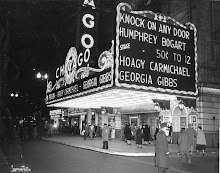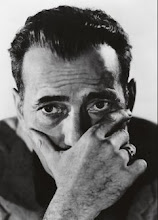It's oh-so tempting to describe this 1934 drama as creaky but that would be oh-so wrong.
Why?
Because creaky suggests noise caused by movement, such as a foot stepping on an old floorboard, and THE MAN WITH TWO FACES is so stiff there's absolutely no discernible movement for the majority of it's (mercifully) short running time.
And no movement equals no creaking noise.
I didn't need the opening credits to tell me this is a film based on a stage play. That is obvious from the story's first moments when we are introduced to the characters all artfully arranged on an oversize country mansion set, and enunciating dialogue at one another with the sole purpose of being heard by those sitting in the back row.
It's not just the volume of the dialogue which shrieks stage play, it's the quality too. From the pacing to the word choice it's completely unreal. The only people in the world who speak this way are actors in a play.
But maybe I'm missing something here. Maybe director Archie Mayo is making an incredibly clever, magnificently subtle point by having his cast perform as if on a Broadway stage instead of the confines of a film studio with it's camera close-ups and ease of access to microphones.
Because THE MAN WITH TWO FACES is a story about a pair of Broadway actors (Mary Astor and Edward G Robinson) and their thwarted efforts to bring a surefire hit play to the Great White Way. And the off-stage action is - if anything - more melodramatic than the fictional play, so perhaps Mayo's making the point that art is simply imitating life.
But this is Great Depression-era Warner Brothers; the home of James Cagney, Edward G Robinson, Joan Blondell, gangster movies, and uplifting tales of ordinary folk struggling to survive and, heck, no one spoke like they were on stage in all those Busby Berkeley backstage musicals so chances are I've not missed anything here, and the reality is that THE MAN WITH TWO FACES is just a dud.
It's not just the dialogue and its delivery that's bad - the stars are miscast too.
Edward G Robinson is one of the finest actors ever to grace the cinema screen but he is not convincing playing a slightly foppish actor so in love with his craft that he doesn't know when to stop acting. As the brother of Mary Astor, playing a super-talented but emotionally fragile actress whose long awaited comeback is threatened by the re-appearance of her good-for-nothing and presumed dead husband Louis Calhern, he puts his acting abilities to deadly use to ensure Calhern can't ruin her career a second time.
Which is where the titular man comes into play. What's weird about this is that it's obvious from the get-go that both faces, despite the disguise, belong to Robinson. Maybe in the theatre, where the audience were further from the stage, the deception might have worked, but there's no hiding from the eye of the camera.
So that's the story's big surprise blown immediately.
Which just leaves us with a far more ho-hum storyline that takes forever to get moving and then resorts to a patently ridiculous and convoluted finale to ensure compliance with the newly introduced Hays Code.
As an amoral cad with an impressive Svengali-like power of control over his wife, Calhern is no more convincing than Robinson, but he is considerably more hammy. Meanwhile Astor must have been so grateful she was playing her part in the era before actors looked for motivation in creating their characters, because it's impossible to ascribe any plausible explanation for her wild mood swings.
Mae Clark, as Robinson's borderline trampy girlfriend, and Emily Fitzroy as a sharp-tongued housekeeper are really the only two cast members to emerge unscathed.
Warner Brothers were turning out movies at such a rapid pace in the early 1930s that they couldn't expect to strike gold every time and THE MAN WITH TWO FACES is a particularly fine example of what hitting tin instead looks and sounds like.
Subscribe to:
Post Comments (Atom)





No comments:
Post a Comment